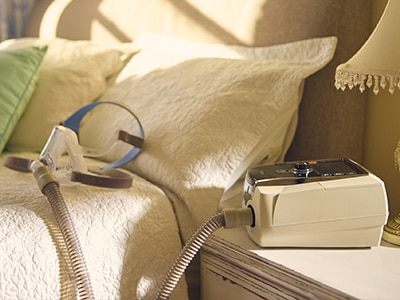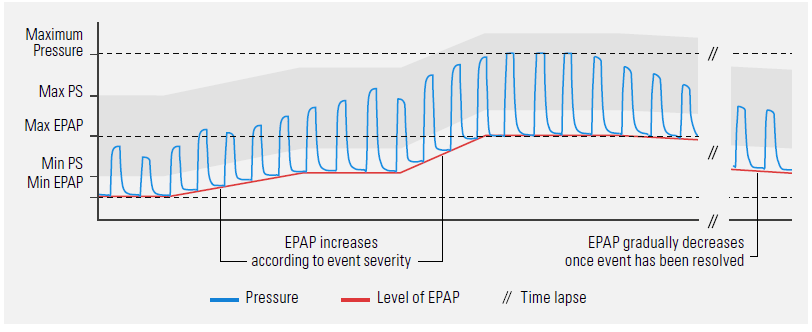What’s the problem?
Your patient’s upper airway can become obstructed as a result of changes in body position, weight, sleep stage, primary condition and medication. Their need for EPAP can also vary from night to night.
What does AutoEPAP do?
AutoEPAP* automatically adjusts expiratory positive airway pressure (EPAP) to maintain an open upper airway. It is designed to prevent full and partial obstructions from occurring and automatically adjusts expiratory pressure settings to address any obstructions that do occur.
How does it work?
- AutoEPAP identifies full and partial obstructions and calculates the severity of the event.
- AutoEPAP addresses full and partial obstructions by automatically adjusting expiratory pressure within Min EPAP and Max EPAP settings. It provides the minimum level of EPAP required to meet your patient’s needs.
- Once the obstructive event has been addressed, it gradually decreases the pressure to re-establish the right balance between upper airway patency and breathing comfort.
Download the AutoEPAP card
Keen to keep this information handy? Download a print-friendly version.
Keep Exploring

ResMed Academy Online
ResMed Academy Online is designed to provide healthcare professionals with easy access to a variety of learning resources.

Ventilation machines
Whether your patient needs mechanical ventilation at home, in hospital or on the move, our versatile ventilation devices provide effective therapy for a wide range of respiratory conditions.

Technical support
Our team of experts work to answer your technical questions relating to ResMed sleep and respiratory devices and software.
*Only available in iVAPS mode. iVAPS mode is available in Lumis 150 ST, Lumis 150 ST-A, Stellar 150 and all Astral variants. iVAPS therapy mode is indicated for patient weighing 30kg and above.
This content is intended for health professionals only. Please refer to the user and clinical guides for relevant information related to any contraindications, warnings and precautions to be considered before and during use of the products.
Update: 03/2024


